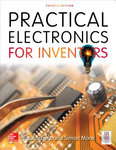1) Practical Electronics for Inventors 4th Edition
https://play.google.com/store/books/details/Paul_Scherz_Prac…
By Paul Scherz and Simon Monk, 1072 pages, McGraw Hill Professional (April 5, 2016)
A Fully-Updated, No-Nonsense Guide to Electronics
Advance your electronics knowledge and gain the skills necessary to develop and construct your own functioning gadgets. Written by a pair of experienced engineers and dedicated hobbyists, Practical Electronics for Inventors, Fourth Edition, lays out the essentials and provides step-by-step instructions, schematics, and illustrations. Discover how to select the right components, design and build circuits, use microcontrollers and ICs, work with the latest software tools, and test and tweak your creations. This easy-to-follow book features new instruction on programmable logic, semiconductors, operational amplifiers, voltage regulators, power supplies, digital electronics, and more.
Practical Electronics for Inventors, 4th Edition, covers:
- Resistors, capacitors, inductors, and transformers
- Diodes, transistors, and integrated circuits
- Optoelectronics, solar cells, and phototransistors
- Sensors, GPS modules, and touch screens
- Op amps, regulators, and power supplies
- Digital electronics, LCD displays, and logic gates
- Microcontrollers and prototyping platforms
- Combinational and sequential programmable logic
- DC motors, RC servos, and stepper motors
- Microphones, audio amps, and speakers
- Modular electronics and prototypes
2) How to Diagnose and Fix Everything Electronic 2nd Ed
https://play.google.com/store/books/details/Michael_Geier_Ho…
By Michael Geier, 416 pages, McGraw Hill Professional (October 31, 2015)
A Fully Revised Guide to Electronics Troubleshooting and Repair
Repair all kinds of electrical products, from modern digital gadgets to analog antiques, with help from this updated book. How to Diagnose and Fix Everything Electronic, Second Edition, offers expert insights, case studies, and step-by-step instruction from a lifelong electronics guru. Discover how to assemble your workbench, use the latest test equipment, zero in on and replace dead components, and handle reassembly. Instructions for specific devices, including stereos, MP3 players, digital cameras, flat-panel TVs, laptops, headsets, and mobile devices are also included in this do-it-yourself guide.
- Choose the proper tools and set up your workbench
- Ensure personal safety and use proper eye and ear protection
- Understand how electrical components work and why they fail
- Perform preliminary diagnoses based on symptoms
- Use test equipment, including digital multimeters, ESR meters, frequency counters, and oscilloscopes
- Interpret block, schematic, and pictorial diagrams
- Disassemble products and identify sections
- Analyze circuits, locate faults, and replace dead parts
- Re-establish connections and reassemble devices


Who else just thought of this?